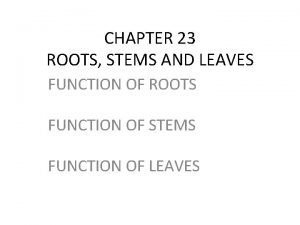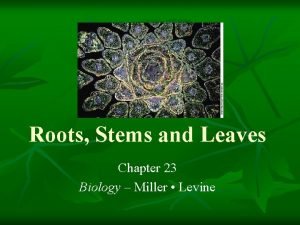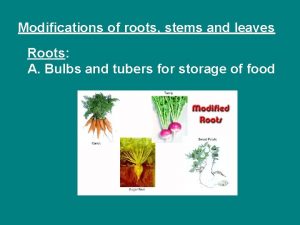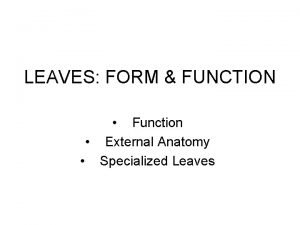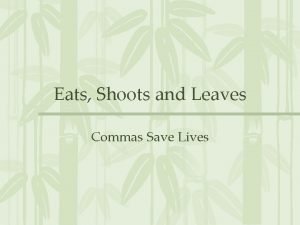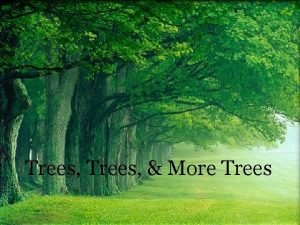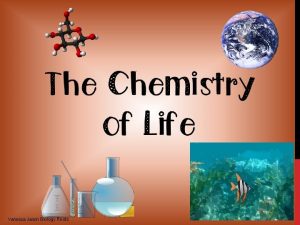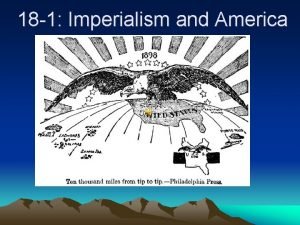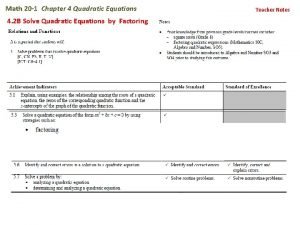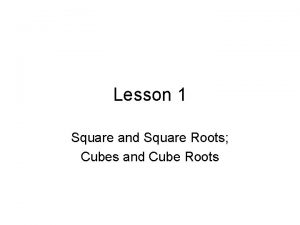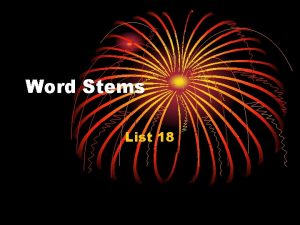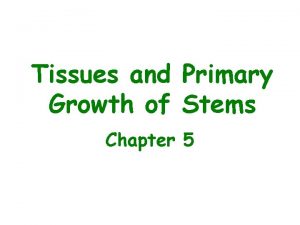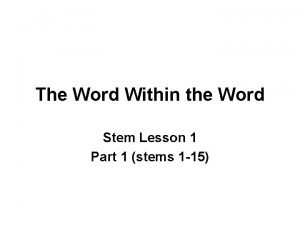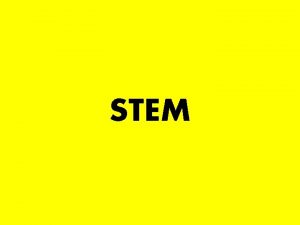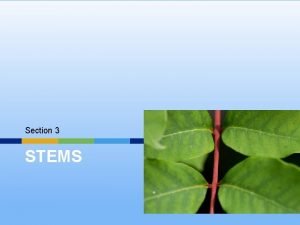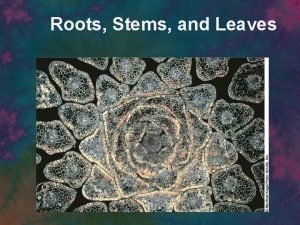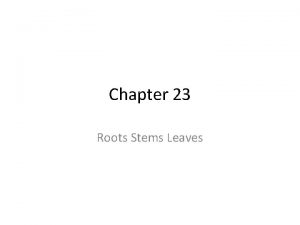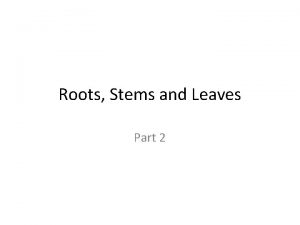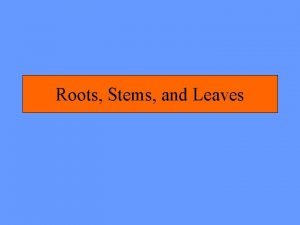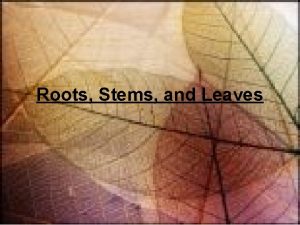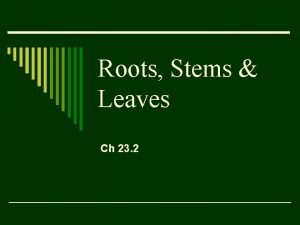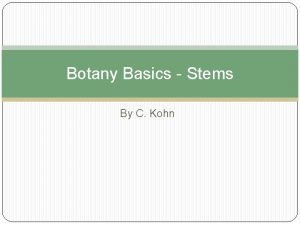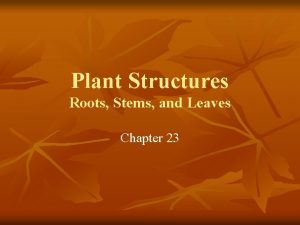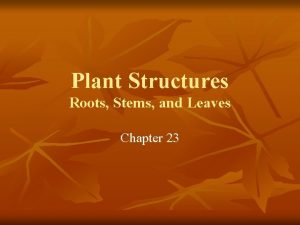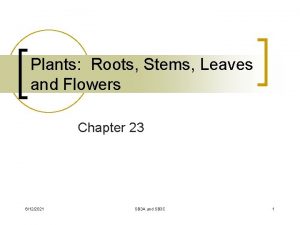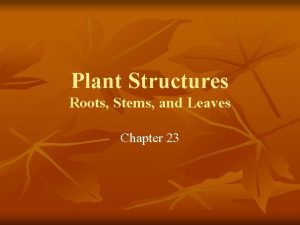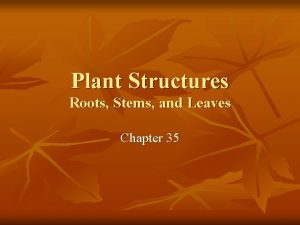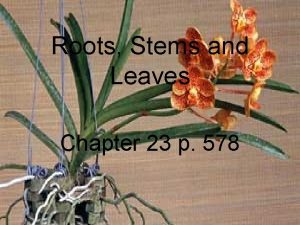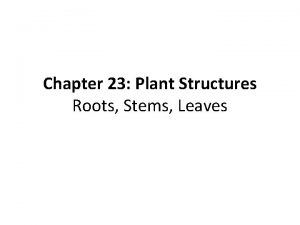Chapter 23 Roots Stems Leaves 23 1 Specialized




















- Slides: 20

Chapter 23 – Roots, Stems, & Leaves

23 -1 Specialized Tissue in Plants • Materials move throughout the plant, and growth and repair take place continuously • Cells work in tandem to ensure plant’s survival

Seed Plant Structure • Three principal organs of seed plants: 1. Roots 2. Stems 3. Leaves These are linked together to perform functions such as transport and protection, as well as coordination of other plant activities.

Roots • Absorbs water and dissolved nutrients • Anchor plant to the ground – holds soil in place and helps prevent erosion • Help in transporting of water & nutrients to the rest of the plant • Aids in keeping plant upright vs. wind and rain

Stems • Has support system for the plant body, transport system to carry nutrients, and defense system against predators & disease • Stem transport system must be able to lift water from roots to the highest leaves, and transport products of photosynthesis from the leaves back down to the roots

Leaves • Photosynthetic system of plant • Increased surface area is good for sunlight absorption but not so good for evaporation • Adjustable pores in leaves help conserve water while letting oxygen and carbon dioxide exit and enter the leaves

Plant Tissue Systems Three main tissue systems: 1. Dermal 2. Vascular 3. Ground

Dermal Tissue • Outer layer – single layer of EPITHELIAL CELLS which are often coated with a thick waxy layer (CUTICLE) that protects against water loss or injury • Some epidermal cells have trichomes which are tiny projections that help protect the leaf and help give it its “fuzzy” look

Dermal Tissue, cont’d. • In roots, dermal tissue contains root hair cells – these provide larger surface area and aid in water absorption • On the underside of leaves, dermal tissue contains guard cells, which regulate water loss and gas exchange

Vascular Tissue • Xylem – water conductor • Phloem – food conductor • Xylem – contains specialized tracheids and vessel elements • Phloem-contains specialized sieve tube elements and companion cells

Xylem • Tracheids are connected to neighboring cells – all seed plants have tracheids • Angiosperms also have a xylem cell that is called a vessel element. They are arranged end to end on top of one another – as the cells mature and then die, it transforms the “stack” of cells into a continuous tube through which water can freely move

Phloem ØMain cells called SIEVE TUBE ELEMENTS which are arranged end to form sieve tubes – end walls have holes that allow material to move back and forth ØWhen sieve tube cells mature, they lose their nuclei and other organelles – the remaining organelles “hug” the cell wall and the rest of the space is a pipeline through which sugars and other foods are carried in a watery stream

Phloem, cont’d. ØCompanion cells are phloem cells that surround sieve tube elements ØThese cells DO NOT lose their nuclei or their organelles ØCompanion cells support the phloem cells and aid in the movement of substances in and out of the phloem

Ground Tissue Cells that lie between dermal and vascular tissue – three types: ØParenchyma – packed with chloroplasts – site of photosynthesis ØCollenchyma – strong, with flexible cell walls that function as support structure ØSclerenchyma – cells that have thick rigid cell walls that add strength to this tissue

Plant Growth & Meristematic Tissue • Most plants have a method of development that involves an open, indeterminate type of growth, which means that they grow and produce new cells at the tips of their roots and stems for as long as they are alive • Cells are produced in meristematic tissue, and are undifferentiated, meaning they are not specific to function at that point of their life

Meristematic Tissue ØNear the tip of each growing root and stem is an apical meristem, which is a group of undifferentiated cells that divide to produce increased length of stems and roots. ØMeristematic tissue is the only plant tissue that produces new cells by mitosis.

Differentiation in Meristematic Tissue • Cells that originate in the meristem look VERY much alike • They divide rapidly and have thin cell walls • Gradually, these cells develop into mature cells with specialized structure and function – this is called differentiation

Differentiation, cont’d. • Specialized cells found in flowers, which make up the reproductive systems of flowering plants, are also produced in meristems. • Flower development begins when certain genes are “turned on” in a shoot apical meristem – this action transforms the apical meristem into a floral meristem (colorful petals & reproductive structures)

Lateral Meristem • Increase width

 Functions of stems
Functions of stems Function of stems
Function of stems Examples of modified roots stems and leaves
Examples of modified roots stems and leaves External anatomy of a stem
External anatomy of a stem Imperfect flowers examples
Imperfect flowers examples Pinnately compound leaf
Pinnately compound leaf Eats shoots and leaves joke explanation
Eats shoots and leaves joke explanation What part of the plant carries and protects the seed
What part of the plant carries and protects the seed Leaves branches trunk and roots song
Leaves branches trunk and roots song Vanessa jason biology roots www.biology-roots.com
Vanessa jason biology roots www.biology-roots.com Square root notes
Square root notes Lesson 3 existence and uniqueness
Lesson 3 existence and uniqueness The roots of american imperialism economic roots
The roots of american imperialism economic roots X 1 2 formula
X 1 2 formula Perfect cubes list
Perfect cubes list Vapor definition
Vapor definition Lateral meristem
Lateral meristem Lesson 1
Lesson 1 Sapwood function
Sapwood function Types of stems
Types of stems Inference question stems
Inference question stems
